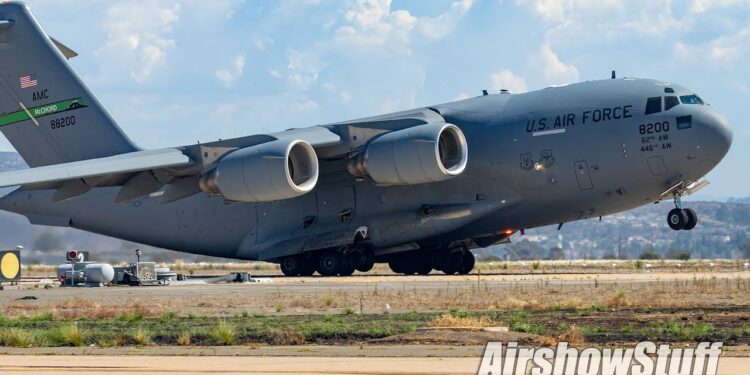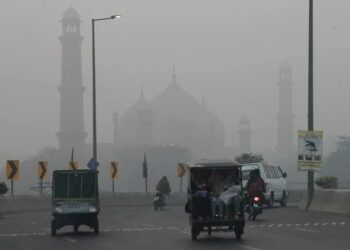Unusual C-17 and C-5 flights from South Korea to the Middle East signal a major U.S. military shift amid rising global tensions.
U.S. Air Force Activity Grabs Attention:
On April 7, 2025, a report by OSINTdefender, a well-known open-source intelligence platform, highlighted something unusual: many large U.S. military planes, like the C-17 and C-5, were flying from South Korea toward the Middle East. These flights were not routine and sparked interest among military watchers.
C-17 and C-5: America’s Flying Giants:
Two of the largest and most powerful transport aircraft in the world are the C-5M Super Galaxy and the C-17 Globemaster III. They transport troops, helicopters, tanks, and missiles. The C-17 can land on difficult, short runways and carry 170,900 pounds. Even more, the C-5M can transport up to 281,000 pounds. These aircraft are not launched carelessly. Usually, their movements hint at something significant.
From South Korea to the Middle East:
Osan Air Base in South Korea. This base is important in the U.S. Indo-Pacific strategy, especially for handling threats from North Korea. It is being used to send equipment and possibly troops toward the Middle East. This suggests a shift in focus or a test of how flexible U.S. military planning can be.
Over 120 Flights:
Between March 25 and April 7, more than 120 U.S. military cargo flights went to the Middle East. These included C-17s, C-5s, C-130s, and refueling planes like KC-135s. Such a high number of flights in a short time is not normal and shows the U.S. is likely preparing for something significant.
Possible Reasons:
No official information has confirmed what these flights are carrying. However, experts believe they might be transporting air defence systems like Patriot missiles or THAAD launchers to help defend allies like Israel or Saudi Arabia from Iranian and Houthi attacks. Recent months have seen more drone and missile attacks in the region. So, reinforcing air defence could be a key reason for these movements.
Closer Look at the Aircraft Capabilities:
Let’s understand why these planes matter:
C-17: Can carry a tank, multiple vehicles, or even helicopters. It is fast, flexible, and reliable.
C-5M: Has a huge cargo bay and can carry big, heavy systems like missile defense equipment. It has been in service for decades and continues to play a vital role in U.S. power projection.
Together, they form the backbone of America’s ability to move military power quickly across the world.
Why Use Osan Air Base?
Osan is about 40 miles south of Seoul and is normally focused on threats from North Korea. So why use it to support the Middle East? Experts believe this could be a way to:
- Test how fast the U.S. can move assets between regions
- Show that America can handle threats in Asia and the Middle East at the same time
- Prepare for long-term changes in global military strategy
What Might Be Onboard?
Without official confirmation, we can only guess. Some possible items being moved include:
- Patriot missile parts
- THAAD systems
- Troops
- Ammunition
- Avenger air defence vehicles
- Spare parts or supplies
Each flight’s cargo may differ, but the scale suggests more than just routine supplies.
What Does This Mean for Asia?
Pulling aircraft and equipment from South Korea might raise concerns. North Korea and China continue to grow their military strength. In 2023, North Korea launched over 30 missiles. China is modernizing its air force and navy quickly. By moving resources from Asia, the U.S. could be seen as leaving gaps in its defences. But it may also be showing that it can shift focus quickly without losing control elsewhere.
Osan Air Base’s History of Flexibility:
Since the Korean War, Osan Air Base has been a significant American base. It has consistently supported both military and humanitarian endeavours, demonstrating its adaptability. For instance, planes based in Osan assisted in delivering relief to Japan during the 2011 disaster. Therefore, even if the current business is large, Osan has previously played a significant role on a global scale.
Rising Tensions in the Middle East:
The military buildup could be in response to increasing problems in the Middle East. In recent months:
- The Houthis in Yemen have attacked ships in the Red Sea.
- Iran has launched missiles at Israel.
- Hezbollah has fired rockets into Israeli territory.
- A C-5M plane recently landed in Israel, possibly carrying more advanced defence systems. These events suggest that the U.S. is preparing for more conflict in the region.
Are Other Countries Watching?
Countries like:
- Israel and Saudi Arabia are likely to welcome the help.
- European allies, especially those near Ramstein Air Base in Germany, may be monitoring the operation.
- China and Russia are probably observing the U.S. response closely.
This kind of large-scale movement sends a message: the U.S. still has global reach and influence.
Fuel and Force:
Each C-17 uses around 5,600 gallons of fuel per hour, and a C-5 can use nearly double that. These missions are expensive and put pressure on both people and equipment. Some C-5 aircraft are over 40 years old. Keeping them flying shows how committed the U.S. is but also how much it depends on older planes.
Global Signal:
This wave of flights is not just about moving things from point A to point B. It’s a clear sign that the U.S. is preparing for new global challenges. Whether it’s a direct response to an upcoming crisis or part of a bigger shift, it shows that American military planning is constantly adjusting.
Final Thoughts:
A strong indication of a strategic shift is the U.S. military’s decision to transport C-17s and C-5s in substantial quantities from Asia to the Middle East. It might have to do with long-term positioning or current threats. In any case, it demonstrates how seriously the Pentagon takes the present international conflicts. As the world observes, these planes bear the burden of contemporary conflict and global expectations in addition to their payload.






















